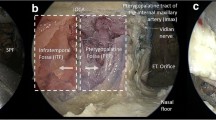Abstract
Aims
To investigate the anatomy of the infratemporal fossa (ITF) and to discuss the practicality of endoscopic transvestibular surgery for an ITF tumor.
Methods
Five fresh cadaveric specimens (10 sides) with vascular silicone injection were prepared for endoscopic anatomy. A transvestibular vertical incision was made along the ramus of the mandible, and pivotal nerves, arteries, and muscles were exposed to sculpt the anatomic landmarks of the ITF.
Results
The endoscopic transvestibular approach exposed the detailed structure of the ITF. The buccinator muscle and the adjoining superior pharyngeal constrictor muscle shaped the paramedian border of the ITF, while the medial pterygoid muscle (MPM) and the lateral pterygoid muscle formed the lateral border. The ITF was delimited by the skull base in the upper margin, and it was proximal to the parapharyngeal space in the inferior part. The inferior alveolar nerve was the first reference point, and the maxillary artery and the lateral pterygoid muscle were also the landmarks of the ITF. The lingual nerve, the eustachian tube (ET), and the middle meningeal artery were also located in the posterior part of the ITF.
Conclusion
The endoscopic transvestibular approach provides a feasible and facile corridor to the ITF. With accurate hemostasis, this approach may provide another option for accessing the ITF for removal of tumors.





Similar content being viewed by others
Abbreviations
- ITF:
-
Infratemporal fossa
- SPCM:
-
Superior pharyngeal constrictor muscle
- MPM:
-
Medial pterygoid muscle
- LPM:
-
Lateral pterygoid muscle
- PPS:
-
Parapharyngeal space
- ICA:
-
Internal carotid artery
- IJV:
-
Internal jugular vein
- MCP:
-
Mandibular coronoid process
- IAN:
-
Inferior alveolar nerve
- PMR:
-
Pterygomandibular raphe
- MMA:
-
Middle meningeal artery
- ET:
-
Eustachian tube
- TMJ:
-
Temporomandibular joint
References
Conley JJ (1956) The surgical approach to the pterygoid area. Ann Surg 144(1):39–43
Barbosa JF (1961) Surgery of extensive cancer of paranasal sinuses. Presentation of a new technique. Arch Otolaryngol (Chicago, Ill.: 1960) 73:129–138
Guo Y, Guo C (2014) Maxillary-fronto-temporal approach for removal of recurrent malignant infratemporal fossa tumors: anatomical and clinical study. J Cranio-Maxillo-Facial Surg 42(3):206–212
Fisch U (1978) Infratemporal fossa approach of tumors of the temporal bone and base skull. J Laryngol Otol 92(11):949–967
Fisch U (1982) Infratemporal fossa approach for glomus tumors of the temporal bone. Ann Otol Rhinol Laryngol 91(5):474–479
Mickey B, Close L, Schaefer S, Samson D (1988) A combined frontotemporal and lateral infratemporal fossa approach to the skull base. J Neurosurg 68(5):678–683
Oakley GM, Harvey RJ (2017) Endoscopic resection of pterygopalatine fossa and infratemporal fossa malignancies. Otolaryngol Clin N Am 50(2):301–313
He H, Yang Q, Gong J et al (2018) Endoscopic transvestibular transmandibular approach for trigeminal schwannoma in infratemporal fossa and parapharyngeal space. World Neurosurg 118:172–176
Dallan I, Fiacchini G, Turri-Zanoni M et al (2016) Endoscopic-assisted transoral-transpharyngeal approach to parapharyngeal space and infratemporal fossa: focus on feasibility and lessons learned. Eur Arch Otorhinolaryngol 273(11):3965–3972
Chan JYK, Li RJ, Lim M, Hinojosa AQ, Boahene KD (2011) Endoscopic transvestibular paramandibular exploration of the infratemporal fossa and parapharyngeal space: a minimally invasive approach to the middle cranial base. Laryngoscope 121(10):2075–2080
Torres-Gaya J, Puche-Torres M, Marques-Mateo M, Garcia Callejo FJ (2019) Transoral (transvestibular-paramandibular) endoscopic approach for benign tumours in the infratemporal fossa. BMJ Case Rep 12:1
Allen WE 3rd, Kier EL, Rothman SL (1973) The maxillary artery: normal arteriographic anatomy. Am J Roentgenol Radium Ther Nucl Med 118(3):517–527
Turri-Zanoni M, Battaglia P, Dallan I, Locatelli D, Castelnuovo P (2016) Multiportal combined transnasal transoral transpharyngeal endoscopic approach for selected skull base cancers. Head Neck 38(6):E2440–e2445
Battaglia P, Turri-Zanoni M, Dallan I et al (2014) Endoscopic endonasal transpterygoid transmaxillary approach to the infratemporal and upper parapharyngeal tumors. Otolaryngology Head Neck Surg. 150(4):696–702
Kuet ML, Kasbekar AV, Masterson L, Jani P (2015) Management of tumors arising from the Parapharyngeal space: a systematic review of 1,293 cases reported over 25 years. Laryngoscope 125(6):1372–1381
Nakaya M, Kida W, Ito A, Yoshihara S, Fuchigami T (2015) Endoscopic transoral and transmaxillary excision of the infratemporal fossa hemangioma. Auris Nasus Larynx 42(3):258–262
Acknowledgments
We are very grateful to Deng Wenyao and Hu Chen for their selfless assistance and admirable work during the anatomic project.
Funding
This research is supported by the Scientific Research Project of Science and Technology Commission of Shanghai Municipality (Project Number: 16411960600).
Author information
Authors and Affiliations
Corresponding author
Ethics declarations
Conflict of interest
There is no financial relationship and conflict of interest among all authors.
Additional information
Publisher's Note
Springer Nature remains neutral with regard to jurisdictional claims in published maps and institutional affiliations.
Rights and permissions
About this article
Cite this article
Fang, Y., Wu, H., Zhao, W. et al. Endoscopic transvestibular anatomy of the infratemporal fossa and upper parapharyngeal spaces for clinical surgery: a cadaver study. Eur Arch Otorhinolaryngol 276, 1799–1807 (2019). https://doi.org/10.1007/s00405-019-05410-y
Received:
Accepted:
Published:
Issue Date:
DOI: https://doi.org/10.1007/s00405-019-05410-y




